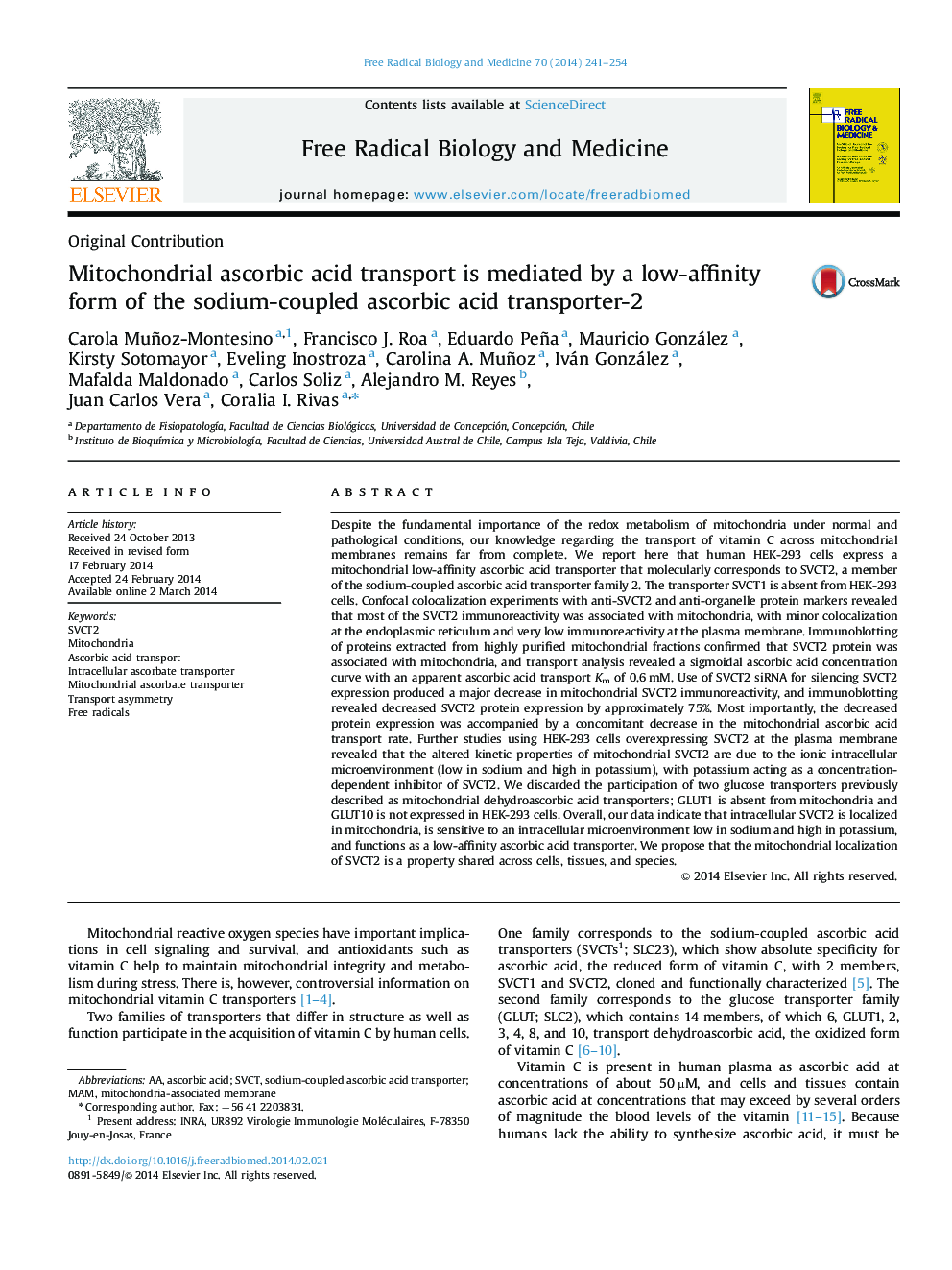| کد مقاله | کد نشریه | سال انتشار | مقاله انگلیسی | نسخه تمام متن |
|---|---|---|---|---|
| 8270488 | 1534972 | 2014 | 14 صفحه PDF | دانلود رایگان |
عنوان انگلیسی مقاله ISI
Mitochondrial ascorbic acid transport is mediated by a low-affinity form of the sodium-coupled ascorbic acid transporter-2
ترجمه فارسی عنوان
حمل و نقل اسید آسکوربیک میتوکندری به وسیله یک فرمول پایین تر از اسید اسکوربیک اسید مایع 2
دانلود مقاله + سفارش ترجمه
دانلود مقاله ISI انگلیسی
رایگان برای ایرانیان
کلمات کلیدی
موضوعات مرتبط
علوم زیستی و بیوفناوری
بیوشیمی، ژنتیک و زیست شناسی مولکولی
سالمندی
چکیده انگلیسی
Despite the fundamental importance of the redox metabolism of mitochondria under normal and pathological conditions, our knowledge regarding the transport of vitamin C across mitochondrial membranes remains far from complete. We report here that human HEK-293 cells express a mitochondrial low-affinity ascorbic acid transporter that molecularly corresponds to SVCT2, a member of the sodium-coupled ascorbic acid transporter family 2. The transporter SVCT1 is absent from HEK-293 cells. Confocal colocalization experiments with anti-SVCT2 and anti-organelle protein markers revealed that most of the SVCT2 immunoreactivity was associated with mitochondria, with minor colocalization at the endoplasmic reticulum and very low immunoreactivity at the plasma membrane. Immunoblotting of proteins extracted from highly purified mitochondrial fractions confirmed that SVCT2 protein was associated with mitochondria, and transport analysis revealed a sigmoidal ascorbic acid concentration curve with an apparent ascorbic acid transport Km of 0.6Â mM. Use of SVCT2 siRNA for silencing SVCT2 expression produced a major decrease in mitochondrial SVCT2 immunoreactivity, and immunoblotting revealed decreased SVCT2 protein expression by approximately 75%. Most importantly, the decreased protein expression was accompanied by a concomitant decrease in the mitochondrial ascorbic acid transport rate. Further studies using HEK-293 cells overexpressing SVCT2 at the plasma membrane revealed that the altered kinetic properties of mitochondrial SVCT2 are due to the ionic intracellular microenvironment (low in sodium and high in potassium), with potassium acting as a concentration-dependent inhibitor of SVCT2. We discarded the participation of two glucose transporters previously described as mitochondrial dehydroascorbic acid transporters; GLUT1 is absent from mitochondria and GLUT10 is not expressed in HEK-293 cells. Overall, our data indicate that intracellular SVCT2 is localized in mitochondria, is sensitive to an intracellular microenvironment low in sodium and high in potassium, and functions as a low-affinity ascorbic acid transporter. We propose that the mitochondrial localization of SVCT2 is a property shared across cells, tissues, and species.
ناشر
Database: Elsevier - ScienceDirect (ساینس دایرکت)
Journal: Free Radical Biology and Medicine - Volume 70, May 2014, Pages 241-254
Journal: Free Radical Biology and Medicine - Volume 70, May 2014, Pages 241-254
نویسندگان
Carola Muñoz-Montesino, Francisco J. Roa, Eduardo Peña, Mauricio González, Kirsty Sotomayor, Eveling Inostroza, Carolina A. Muñoz, Iván González, Mafalda Maldonado, Carlos Soliz, Alejandro M. Reyes, Juan Carlos Vera, Coralia I. Rivas,
